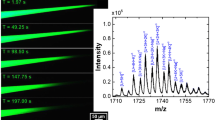Abstract
Insights into the electrolysis of analytes at the electrode surface of an electrospray (ES) emitter capillary are realized through an examination of the results from off-line chronopotentiometry experiments and from mass transport calculations for flow through tubular electrodes. The expected magnitudes and trends in the interfacial potential in an ES emitter under different solution conditions and current densities, using different metal electrodes, are revealed by the chronopotentiometry data. The mass transport calculations reveal the electrode area required for complete analyte electrolysis at a given volumetric flow rate. On the basis of these two pieces of information, the design of ES emitters that may maximize and those that may minimize analyte electrolysis during ES mass spectrometry are discussed.
Similar content being viewed by others
References
Blades, A. T.; Ikonomou, M. G.; Kebarle, P. Mechanism of electrospray mass spectrometry. Electrospray as an electrolysis cell. Anal. Chem. 1991, 63, 2109–2114.
Van Berkel, G. J.; Zhou, F. Characterization of an electrospray ion source as a controlled-current electrolytic cell. Anal. Chem. 1999, 64, 1586–1593.
Van Berkel, G. J. In Electrospray Ionization Mass Spectrometry; Cole, R. B., Ed.; Wiley: New York, 1997; Chap 1, pp 65–105.
Jackson, G. S.; Enke, C. G. Electrical equivalence of electrospray ionization with conducting and nonconducting needles. Anal. Chem. 1999, 71, 3777–3784.
Kebarle, K.; Ho, Y. In Electrospray Ionization Mass Spectrometry; Cole, R. B., Ed.; Wiley: New York, 1997; Chap 2, pp 3–63.
Charbonnier, F.; Rolando, C.; Saru, F.; Hapiot, P.; Pinson, J. Short time-scale observation of an electrospray current. Rapid Commun. Mass Spectrom. 1993, 7, 707–710.
Van Berkel, G. J.; McLuckey, S. A.; Glish, G. L. Electrochemical origin of radical cations observed in electrospray ionization mass spectra. Anal. Chem. 1992, 64, 1586–1593.
Xu, X.; Nolan, S. P.; Cole, R. B. Electrochemical oxidation and nucleophilic addition reactions of metallocenes in electrospray mass spectrometry. Anal. Chem. 1994, 66, 119–125.
Dupont, A.; Gisselbrecht, J. P.; Leize, E.; Wagner, L.; Van Dorsselaer, A. Electrospray mass-spectrometry of electrochemically ionized molecules—Application to the study of fullerenes. Tetrahedron Lett. 1994, 35, 6083–6086.
Van Berkel, G. J.; Zhou, F. Electrospray as a controlled-current electrolytic flow cell: Electrochemical ionization of neutral analytes for detection by electrospray mass spectrometry. Anal. Chem. 1995, 67, 3958–3964.
Hiraoka, K.; Aizawa, K.; Murata, K. Electrochemical reduction and highly-sensitive analysis of iodine in electrospray mass spectrometry. J. Mass Spectrom. Soc. Jpn. 1995, 43, 77–83.
Van Berkel, G. J.; Zhou, F. Observation of gas-phase molecular dications formed from neutral organics in solution via the controlled-current electrolytic process inherent to electrospray. J. Am. Soc. Mass Spectrom. 1996, 7, 157–162.
Karancsi, T.; Slégel, P.; Novák, I.; Pirok, G.; Kovács, P.; Vékey, K. Unusual behavior of some isochromene and benzofuran derivatives during electrospray ionization. Rapid. Commun. Mass Spectrom. 1997, 11, 81–84.
Vandell, V. E.; Limbach, P. A. Electrospray ionization mass spectrometry of metalloporphyrins. J. Mass Spectrometry 1998, 33, 212–220.
McCarley, T. D.; Lufaso, M. W.; Curtin, L. S.; McCarley, R. L. Multiply charged redox-active oligomers in the gas phase: Electrolytic electrospray ionization mass spectrometry of metallocenes. J. Phys. Chem. B. 1998, 102, 10078–10086.
Van Berkel, G. J.; Quirke, J. M. E.; Tigani, R. A.; Dilley, A. S.; Covey, T. R. Derivatization for electrospray ionization mass spectrometry. 3. Electrochemically ionizable derivatives. Anal. Chem. 1998, 70, 1544–1554.
Bateman, K. P. Electrochemical properties of capillary electrophoresis-nanoelectrospray mass spectrometry. J. Am. Soc. Mass Spectrom. 1999, 10, 309–317.
Schoener, D. F.; Olsen, M. A.; Cummings, P. G.; Basic, C. Electrospray ionization of neutral metal dithiocarbamate complexes using in-source oxidation. J. Mass Spectrom. 1999, 34, 1069–1078.
Van Berkel, G. J.; Zhou, F.; Aronson, J. T. Changes in bulk solution pH caused by the inherent controlled-current electrolytic process of an electrospray ion source. Int. J. Mass Spectrom. Ion Processes 1997, 162, 55–67.
Van Berkel, G. J.; Electrolytic corrosion of a stainless-steel electrospray emitter monitored using an electrospray-photodiode array system. J. Anal. At. Spectrom. 1998, 13, 603–607.
Van Berkel, G. J.; Giles, G. E.; Bullock, J. S., IV; Gray, L. J. Computational simulation of redox reactions within a metal electrospray emitter. Anal. Chem. 1999, 71, 5288–5296.
Bard, A. J.; Faulkner, L. R. Electrochemical Methods; Wiley: New York, 1980.
Dobos, D. Electrochemical Data; Elsevier: Amsterdam, 1975.
Wilm, M.; Mann, M. Analytical properties of the nanoelectrospray ion source. Anal. Chem. 1996, 68, 1–8.
Chen, L.; Colyer, C. L.; Kamau, M. G.; Myland, J. C.; Oldham, K. B.; Symons, P. G. Microtube flowing coulometry. Can. J. Chem. 1994, 72, 836.
Kuwana, T.; Bublitz, D. E.; Hoh, G. Chronopotentiometric studies on the oxidation of ferrocene, ruthenocene, osmocene and some of their derivatives. J. Am. Chem. Soc. 1960, 82, 5811–5817.
Hayati, I. Eddies inside a liquid cone stressed by interfacial electricial shear. Colloids Surf. 1992, 65, 77–84.
Morand, K.; Talbo, G.; Mann, M. Oxidation of peptides during electrospray ionization. Rapid Commun. Mass Spectrom. 1993, 7, 738–743.
Moini, M.; Cao, P.; Bard, A. J. Hydroquinone as a buffer additive for suppression of bubbles formed by electrochemical oxidation of the CE buffer at the outlet electrode in capillary electrophoresis/electrospray ionization-mass spectrometry. Anal. Chem. 1999, 71, 1658–1661.
Severs, J. C.; Harms, A. C.; Smith, R. D. A new high-performance interface for capillary electrophoresis/electrospray ionization mass spectrometry. Rapid Commun. Mass Spectrom. 1996, 10, 1175–1178.
Severs, J. C.; Smith, R. D. Characterization of the microdialysis junction interface for capillary electrophoresis/microelectrospray ionization mass spectrometry. Anal. Chem. 1997, 69, 2154–2158.
Author information
Authors and Affiliations
Corresponding author
Rights and permissions
About this article
Cite this article
Van Berkel, G.J. Insights into analyte electrolysis in an electrospray emitter from chronopotentiometry experiments and mass transport calculations. J. Am. Soc. Spectrom. 11, 951–960 (2000). https://doi.org/10.1016/S1044-0305(00)00175-6
Received:
Revised:
Accepted:
Issue Date:
DOI: https://doi.org/10.1016/S1044-0305(00)00175-6




